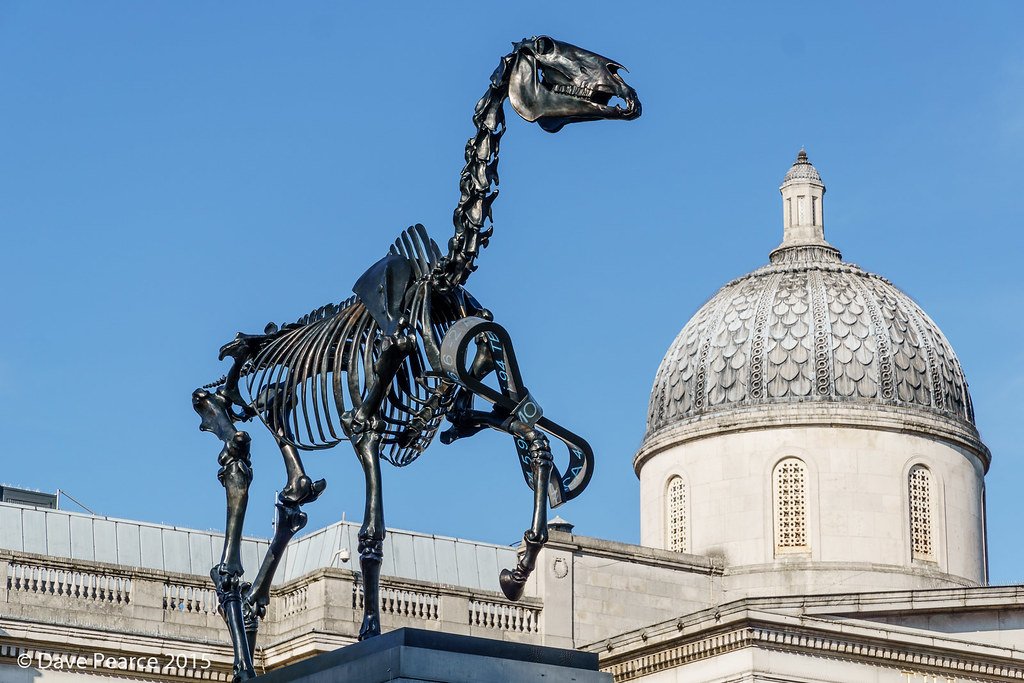Exhibition: Fourth Plinth Maquettes
The winning artworks were on display in the main entrance of The Royal London Hospital; David Shrigley’s ‘Really Good’ and Hans Haacke’s ‘Gift Horse’. Photography by Joe Clark.
June 2014 – March 2015
Staff and visitors using the new entrance at The Royal London Hospital received an early glimpse of two of the artworks that will adorn the coveted Fourth Plinth in Trafalgar Square. Since 2005, Trafalgar Square’s Fourth Plinth has been home to a range of stunning world-class contemporary artworks. Funded by the Mayor of London, the commission has become one of the most high profile contemporary art prizes in the world. Hans Haacke and David Shrigley were announced in February 2014 as the winning artists for the next two Fourth Plinth commissions in Trafalgar Square. Vital Arts is delighted to bring the winning maquettes to The Royal London for the enjoyment of patients, visitors and staff. Over one million people attend the six hospitals within our trust each year, looked after by 15,000 members of staff. We see these important civic spaces as ideal places to introduce a new audience to contemporary art. Their artworks will be unveiled in Trafalga Square in 2015 and 2016 respectively.
Hans Haacke – Gift Horse
Materials: bronze, electroluminescent film
Unveiled in 2015
Image Credit: "Gift Horse on the 4th plinth." by Dave Pearce (London) is licensed under CC BY-NC-ND 2.0.
Instead of the statue of William IV astride a horse, as originally planned for the empty plinth, Hans Haacke proposes a skeleton of a riderless, strutting horse. Tied to the horse’s front leg is an electronic ribbon which displays live the ticker of the London Stock Exchange, completing the link between power, money and history. The horse is derived from an etching by George Stubbs, whose studies of equine anatomy were published the year after the birth of the reputedly decadent king, whose statue was abandoned due to a lack of funds. Haacke’s proposal makes visible a number of ordinarily hidden substructures, tied up with a bow as if a gift to all.
Haacke’s early work employed physical and organic processes, such as condensation, in what he called ‘systems’, until his focus shifted to the socio-political field of equally interdependent dynamics. For the last four decades Haacke has been examining relationships between art, power and money, and has addressed issues of free expression and civic responsibilities in democratic societies. Haacke’s practice is difficult to categorise, moving from object to image to text, from painting to photography, at times of a provocative nature.
Hans Haacke was born 1936 in Cologne, Germany. He lives and works in New York.
David Shirley – Really Good
Material: Bronze
Unveiled in 2016
Image Credit: "Really Good" by diamond geezer is licensed under CC BY-NC-ND 2.0.
A giant hand in a thumbs-up gesture, and with a really long thumb at that, must mean that something, somewhere, is really good. But what is that something and where is it? Is it Trafalgar Square? Or all of London? Or maybe the artwork itself? And if it’s so good, why is that? Who says so? And will we agree?
Really Good will be cast in bronze with the same dark patina as the other statues in the Square, the comic extension of the thumb bringing it up to ten metres in height. Shrigley’s ambition is that this will become a self-fulfilling prophecy; that things considered ‘bad’, such as the economy, the weather and society, will benefit from a change of consensus towards positivity.
Shrigley’s daily tirade of satirical vignettes takes the British tradition of satire into three and four dimensions. In his drawings and animations protagonists express their dark impulses and are subject to the violence and irrationality of life, while his sculptures are often jokes in 3D form, reflecting the absurdity of contemporary society.
David Shrigley was born in 1968 in Macclesfield. He lives and works in Glasgow.
All Fourth Plinth commissions can be viewed at here.



